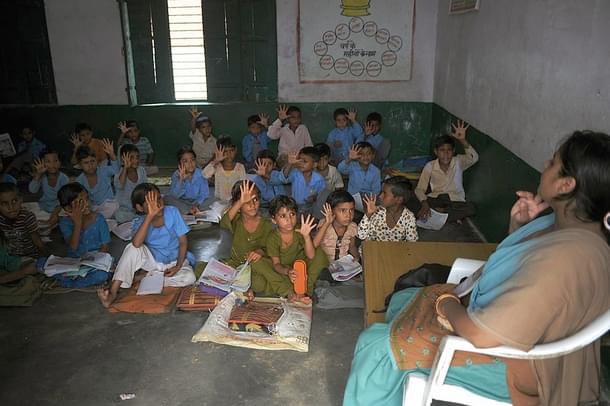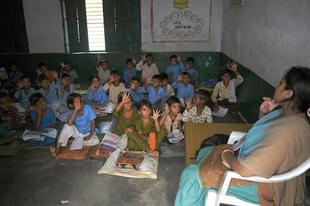Ideas
Samagra Shiksha Abhiyan Is Just Old Wine In A New Bottle
Swarajya Special
May 03, 2018, 12:36 PM | Updated 12:36 PM IST
Save & read from anywhere!
Bookmark stories for easy access on any device or the Swarajya app.


The Minister of Human Resource Development Prakash Javadekar is undoubtedly the most reformist minister in the history of independent India when it comes to higher education. The Indian Institute of Management (IIM) Autonomy Bill, the initiative to provide graded autonomy to higher education institutions, the initiative to develop 20 institutes of eminence, mainstreaming of Study Webs of Active –Learning for Young Aspiring Minds(SWAYAM) etc. have won him his place in history books already.
Given all this, it is perplexing that his interventions in the school education department have been feeble, centralising and devoid of the spirit of deep reform. Make no mistake, the Department of School Education has done some excellent work in teacher education reforms, instituting National Assessment Survey etc. But the fundamental recasting of school education that has been crying for reforms has been met with the new Samagra Shiksha Abhiyan(SMSA).
The SMSA integrates the Sarva Shiksha Abhiyan (SSA) that is targeted at primary schooling (Class 1-8), Rashtriya Madhyamik Siksha Abhiyan (RMSA) that is targeted at secondary schooling (Class 9-12) and Teacher Education (TE). A new Centrally sponsored scheme, a bureaucratic behemoth, is thus created. The budget allocated for SSA and RMSA is about Rs. 30,000 crores for the fiscal year (FY) 2018.
The rationale for the integration of the new schemes, as explained by the government, is that there is a need to rationalise resources. It contends that upto school level there are personnel who deal exclusively with SSA or RMSA. New initiatives such as more allocation for Kasturba Gandhi Balika Vidyalaya(KGBV), the allocation for Khelo India etc. have also been made, though these initiatives could have been carried out independent of the integration.
If the government wanted to undertake path-breaking reform and leave footprints in the sands of time, the last thing for it to do was to let the zealous bureaucracy do a rejig of bureaucratic programs to solve the problems created by the very same bureaucracy in the first place and then rechristen it with a similar name. This gives way to usual opposition jibes on the government of doing namesake reforms. If the government intends to leave an imprint in the school education system it could have looked at it as-is, at the interventions that are required, at the opportunities for liberalisation that could lead to accountability and efficiency, look for silo-breaking opportunities with the work of other ministries etc. Reforming the right to education(RTE) act, erecting a sane regulatory structure for low-cost private schools, though beyond the scope of the SSA rejig, remain pipe dreams.
The old SSA has been successful in erecting educational infrastructure in every nook and corner of the country. For primary schools, the enrolment has been close to 100 per cent. The focus now is on learning outcomes that have been exposed by the NAS and Pratham’s ASER. This would have been an excellent opportunity to decentralise and place lower primary education (classes 1 to 5) in the hands of the state governments. An integration with the Integrated Child Development Services (ICDS) run by the Ministry of Women and Child development would have provided a seamless graduation of the child from anganwadis to primary schools. By placing the onus of lower primary schools on the states, accountability could have been fixed. The State Council Educational Research and Training (SCERTs) and District Institute of Education and Training (DIETs) would have been rejuvenated naturally to cater to the needs of primary schools, instead of the belaboured top-down approach recommended under the new SMSA. These institutes would have been tasked with creating curriculum and offering lessons in local languages. The feet of the Chief Minister and the State Education minister would have been held to the fire for outcomes. Remember, till the 1976 constitutional amendment, education in its entirety was on the state list of the constitution.
The central government could have squarely focussed on the higher primary and secondary segments, basically from class 6 to 12. Bringing together programs from the Ministry of Health, the Ministry of Sports and the Ministry of Skill Development would have provided a platform for issues relevant to adolescents to be looked at in a holistic fashion. A good high school education pretty much would imbibe in a child all the skills and competencies required for it to make a decent living. College education would be for further specialisation.
The enrolment ratio of upper primary school is at 91 per cent and secondary school is at 78 per cent. The infrastructure in labs and pedagogy is still evolving. This should have been the exclusive focus of the Department of School Education under MHRD. It should have re-engineered the RMSA into incorporating exciting new advancements in technology, pedagogy and remodelled it into a flagship program destined to take our young minds into the new era. Concepts like the NITI Aayog pioneered Atal Tinkering Labs, vocational education, a remodelled curriculum on our history and culture would have been welcome.
Now under the new SMSA, both the centre and states can blame each other for underperformance. It is also strange that the ideas put forth in the forward-looking India Action Plan of 2016-19 created by the Niti Aayog are not applied in spirit.
The Congress, although, has no moral authority to criticise the new SMSA, for this would never come up if not for the mess it created. And about Arjun Singh and Kapil Sibal as HRD ministers, the less said, the better. The left-liberal intelligentsia that loves centralisation and sarkari control would have no qualms with the new RMSA, at least philosophically. This government alone could have done it.
We may have to wait for at least six years for structural reforms in school education because post-2019, neither will the National Democratic Alliance (NDA)-III want to touch it again nor will the United Progressive Alliance (UPA-) IV have the stomach for it.





